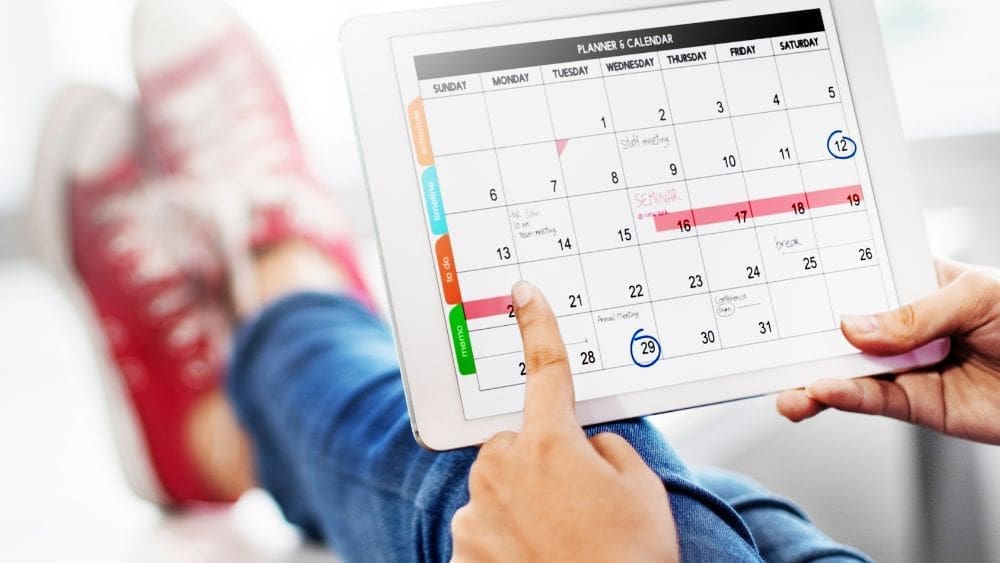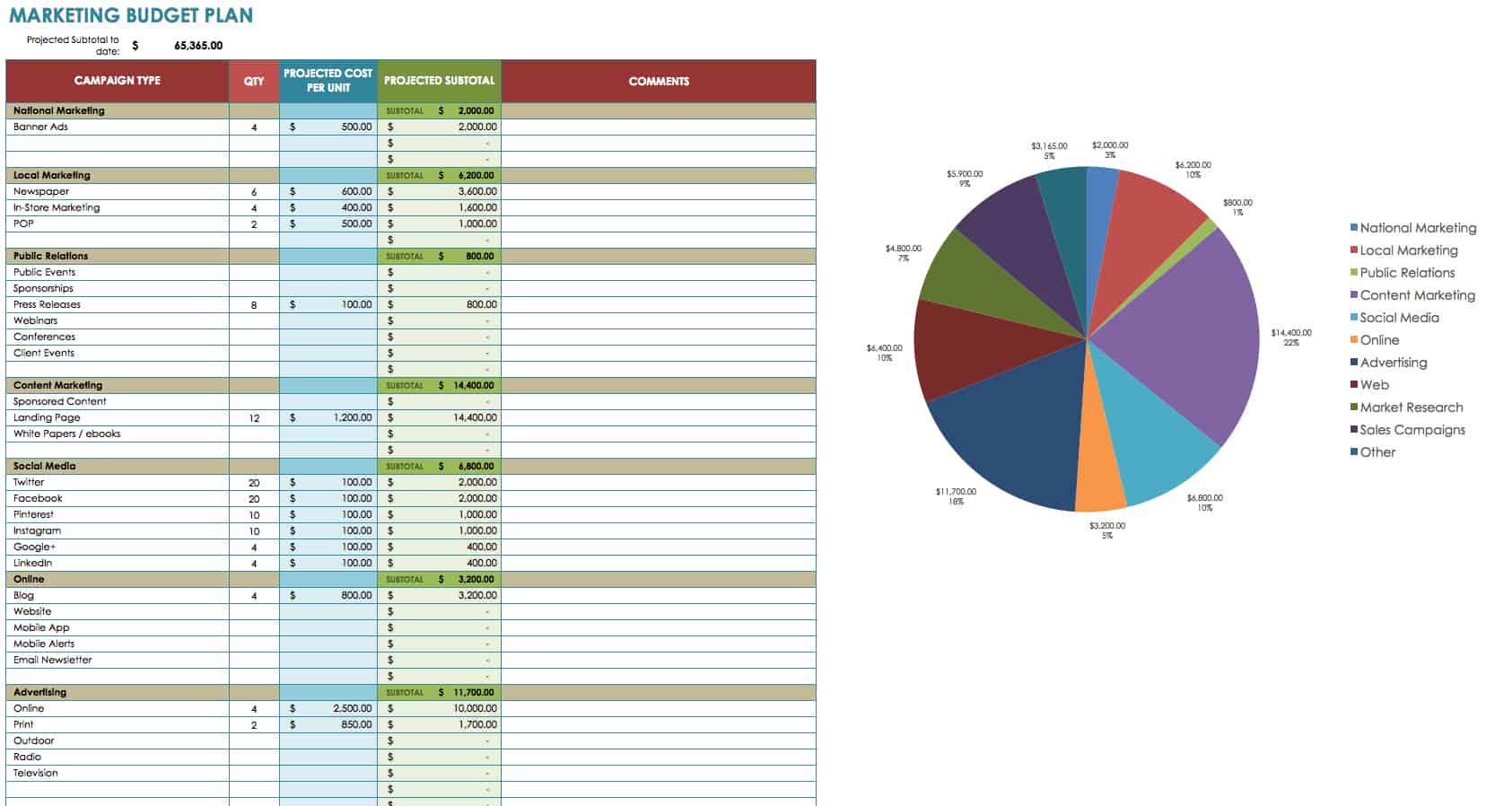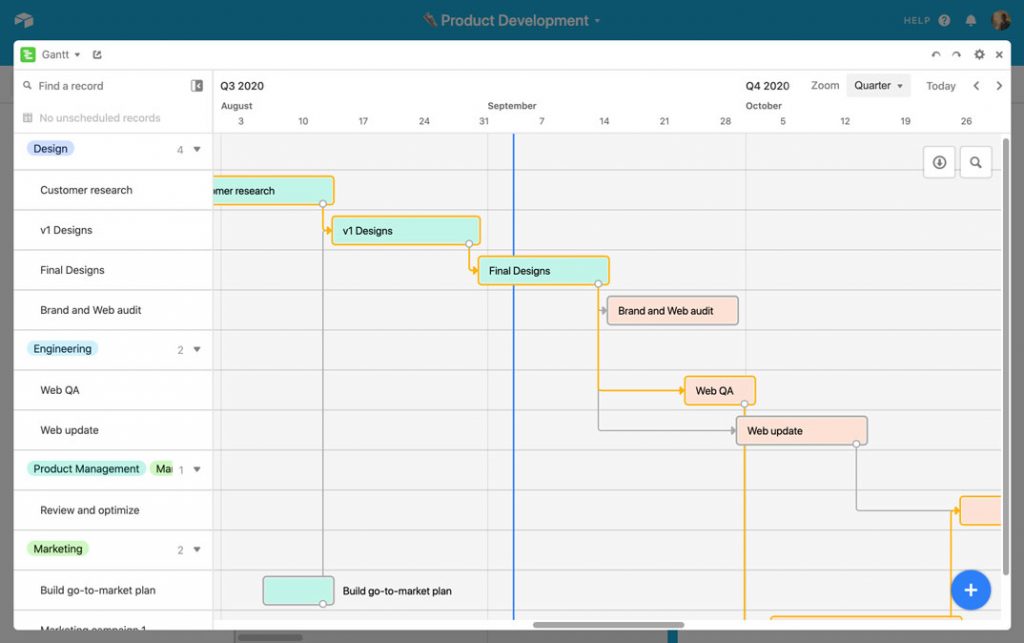
Published: Nov 30, 2024
How to Create a Killer Content Calendar in 7 Easy Steps
How to Create a Killer Content Calendar in 7 Easy Steps
I’ve been in the content trenches for years, and let me tell you, creating a content calendar is like planning the perfect date night - it takes some effort, but the payoff is so worth it! So grab your favorite beverage, and let’s dive into the juicy world of content planning. Trust me, by the end of this, you’ll be calendar-ing like a pro!
TLDR: What exactly is a content calendar and why do I need one?
1️⃣ What is a content calendar?
A content calendar is your secret weapon for organizing and scheduling all your content across different platforms. It’s like having a personal assistant who never forgets a post or misses a deadline.
2️⃣ Why is a content calendar crucial for my business?
A well-crafted content calendar keeps you consistent, helps you plan ahead, and ensures you’re hitting all your marketing goals. It’s the difference between randomly throwing darts and hitting the bullseye every time.
3️⃣ How can a content calendar improve my content strategy?
With a content calendar, you can align your content with important dates, track performance, and maintain a consistent brand voice. It’s like having a roadmap for your content journey – you’ll always know where you’re going and how to get there.
Table of Contents
- Step 1: Define Your Content Goals
- Step 4: Select Your Tools
- Step 5: Plan Your Content Topics
- Step 6: Create Your Calendar
- Choose Your Calendar Format
- Set Up Your Calendar Structure
- Plan Your Posting Frequency
- Balance Your Content Mix
- Schedule Around Important Dates
- Use Time-Blocking
- Create a Content Bank
- Include Call-to-Actions (CTAs)
- Plan for Social Listening
- Use a Content Calendar Template
- Tools to Consider
- Final Tips
- Step 7: Review and Adjust
- Step 2: Know Your Audience
- Create Buyer Personas
- Example Buyer Persona: Meet Sarah the Social Media Manager
- Use Data to Inform Decisions
- Tools for Audience Research
- Listen to Your Audience
- Engage and Ask Questions
- Analyze Your Competition
- Create Content for Different Stages of the Buyer’s Journey
- Keep Your Finger on the Pulse
- Test and Learn
- Step 3: Choose Your Content Types
- Bonus: Content Calendar Templates
- FAQs About Content Calendars
- What is a content calendar?

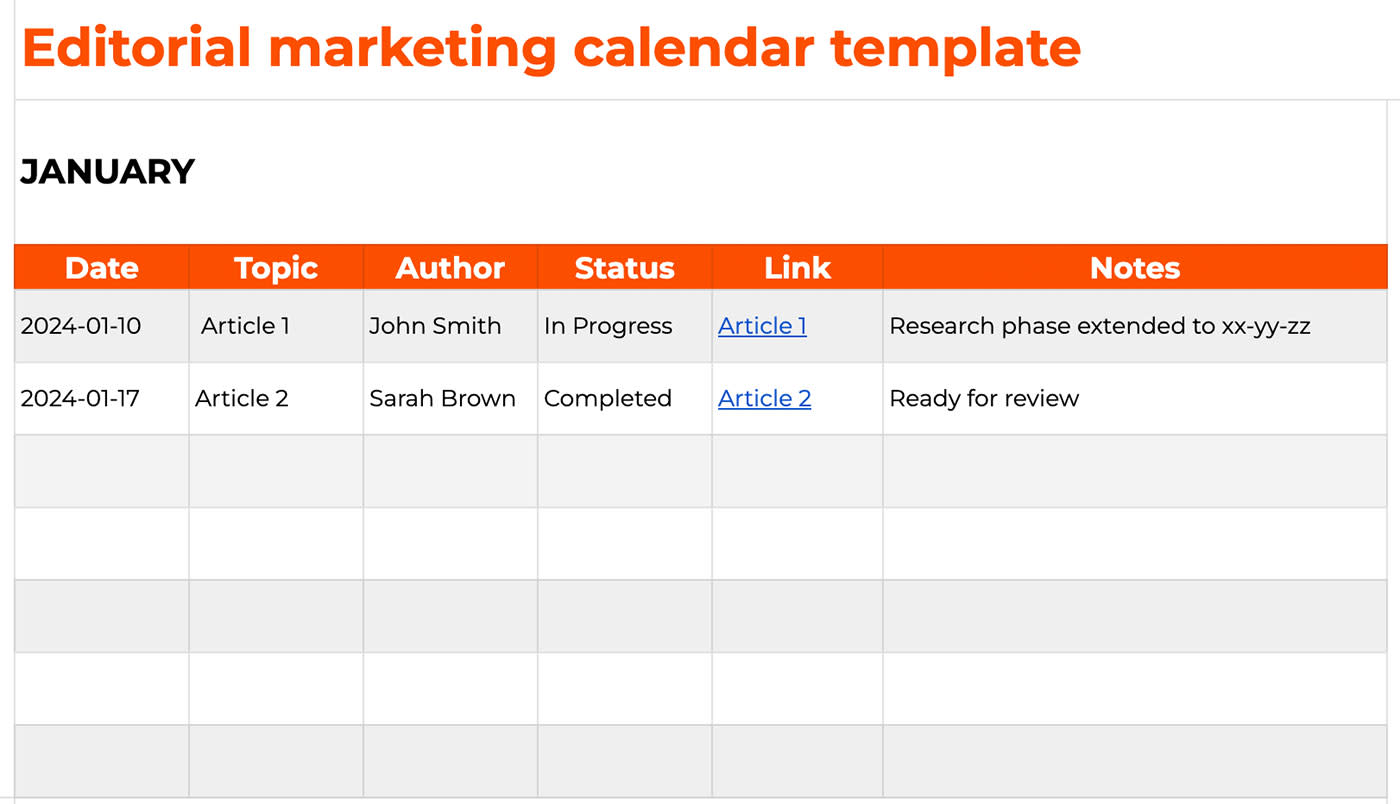
- How often should I update my content calendar?
- What should I include in my content calendar?
- How far in advance should I plan my content?
- Can a content calendar help with SEO?
- What tools can I use to create a content calendar?
- How do I come up with content ideas for my calendar?
- Should I plan different content for different platforms?
- How do I measure the success of my content calendar?
- What if I can’t stick to my content calendar?
- Can I use a content calendar for multiple brands or clients?
- How do I balance planned content with real-time engagement?
- What is a content calendar?
Step 1: Define Your Content Goals
Let’s kick things off with a bang! Defining your content goals is like setting the GPS for your content journey. Without them, you’re just wandering around aimlessly in the digital wilderness.
Align with Your Business Objectives
First things first, your content goals need to play nice with your overall business objectives. Are you trying to boost brand awareness? Drive more traffic to your website? Or maybe you’re all about generating those sweet, sweet leads. Whatever it is, make sure your content goals are in sync.
For example, if you’re running an e-commerce store selling handmade jewelry, your goal might be to increase product page visits by 20% in the next quarter. That’s specific and measurable - exactly what we’re looking for!
Make Your Goals SMART
Remember that acronym from school? It’s time to dust it off because SMART goals are your new best friend:
- Specific: Don’t be vague. “Get more followers” is out. “Increase Instagram followers by 1,000” is in.
- Measurable: If you can’t measure it, you can’t improve it. Use numbers and percentages.
- Achievable: Be ambitious, but realistic. Gaining 1 million followers overnight? Probably not happening.
- Relevant: Make sure your goals align with your overall strategy. No point in chasing TikTok fame if your audience is all on LinkedIn.
- Time-bound: Set a deadline. It creates urgency and helps you stay on track.
Examples of SMART Content Goals
- Increase website traffic by 25% in the next 3 months through bi-weekly blog posts and daily social media updates.
- Generate 50 new email newsletter sign-ups per month by offering a free downloadable e-book on our website.
- Boost engagement rate on Instagram by 15% in the next quarter by posting user-generated content twice a week.
Track Your Progress
Now that you’ve set your goals, it’s time to keep tabs on them. Use tools like Google Analytics or Hootsuite to track your progress. Set up a simple spreadsheet or use a project management tool to log your metrics regularly.
Remember, your goals aren’t set in stone. If you find you’re smashing them out of the park, set the bar higher. If you’re struggling, it might be time to reassess and adjust.
By defining clear, measurable content goals, you’re setting yourself up for success. It’s like having a roadmap for your content journey - you’ll always know where you’re heading and how far you’ve come. So go ahead, dream big, but keep it SMART!
Step 4: Select Your Tools
Alright, let’s talk tools! Picking the right tools for your content calendar is like choosing the perfect outfit for a first date - it can make or break your success. But don’t worry, I’ve got your back. Let’s dive into some options that’ll make your content planning a breeze.
Google Sheets

Google Sheets is the trusty Swiss Army knife of content calendars. It’s free, it’s collaborative, and it’s surprisingly powerful.
Pros:
- Easy to use and share with your team
- Customizable to fit your specific needs
- Integrates well with other Google tools
Cons:
- Can get messy with large amounts of data
- Limited design options
Pro Tip: Use color coding to visually organize different types of content or platforms. It’s like giving your calendar a mini-makeover!
Trello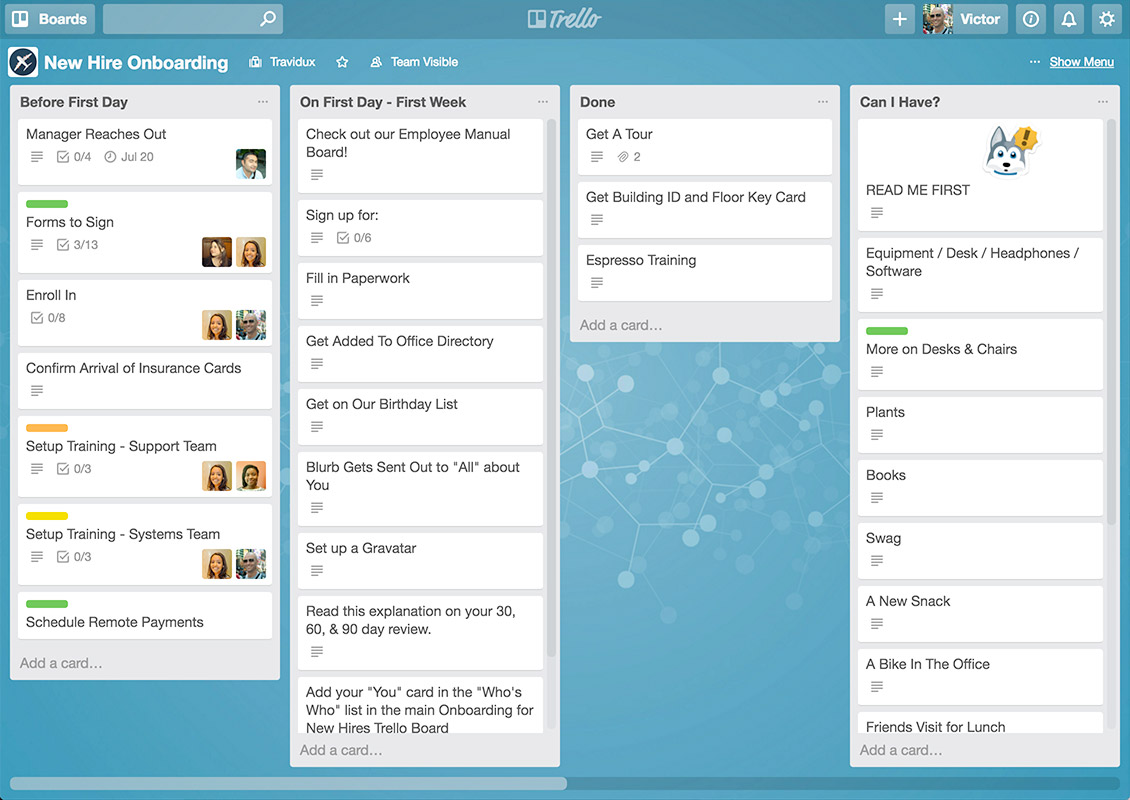
If you’re a visual thinker, Trello’s board-based system might be your new best friend.
Pros:
- Intuitive drag-and-drop interface
- Great for visualizing your content pipeline
- Has a free version with plenty of features
Cons:
- Can get cluttered with too many boards
- Limited reporting capabilities
Cool Feature: Trello’s calendar power-up lets you view your boards in a calendar format. It’s like having your cake and eating it too!
Asana

Asana is the heavyweight champion of project management tools, and it’s fantastic for content calendars too.
Pros:
- Robust task management features
- Multiple view options (list, board, calendar, timeline)
- Great for larger teams and complex projects
Cons:
- Steeper learning curve
- Can be overkill for smaller teams or simpler needs
Insider Tip: Use Asana’s custom fields to track things like content status, target audience, or key performance indicators. It’s like giving your content superpowers!
CoSchedule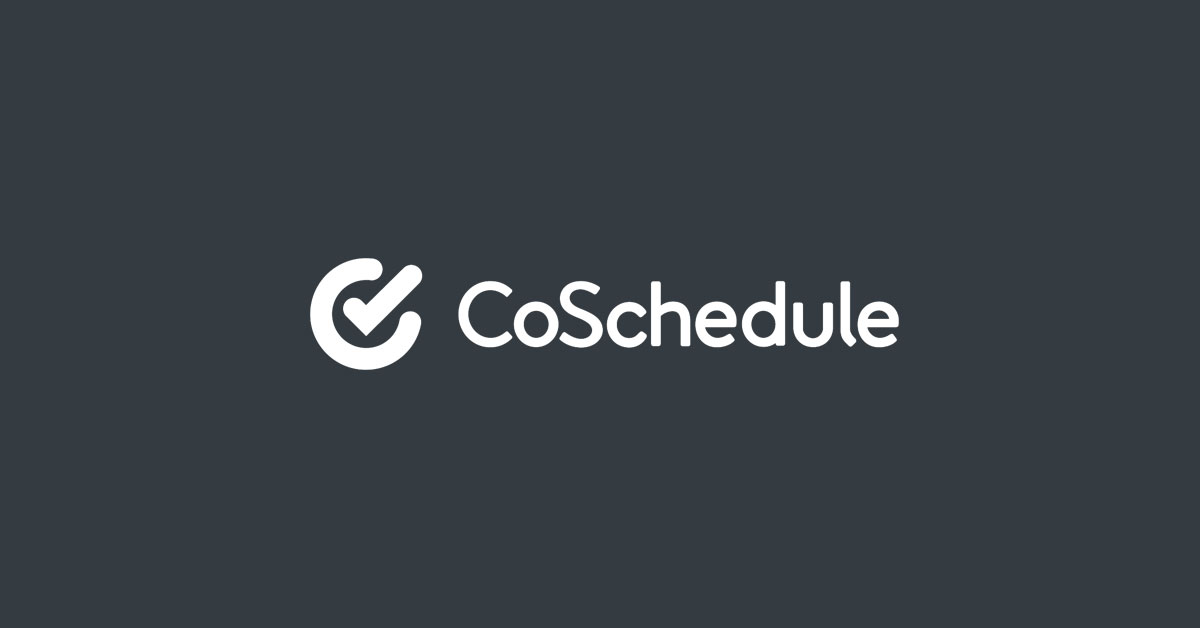
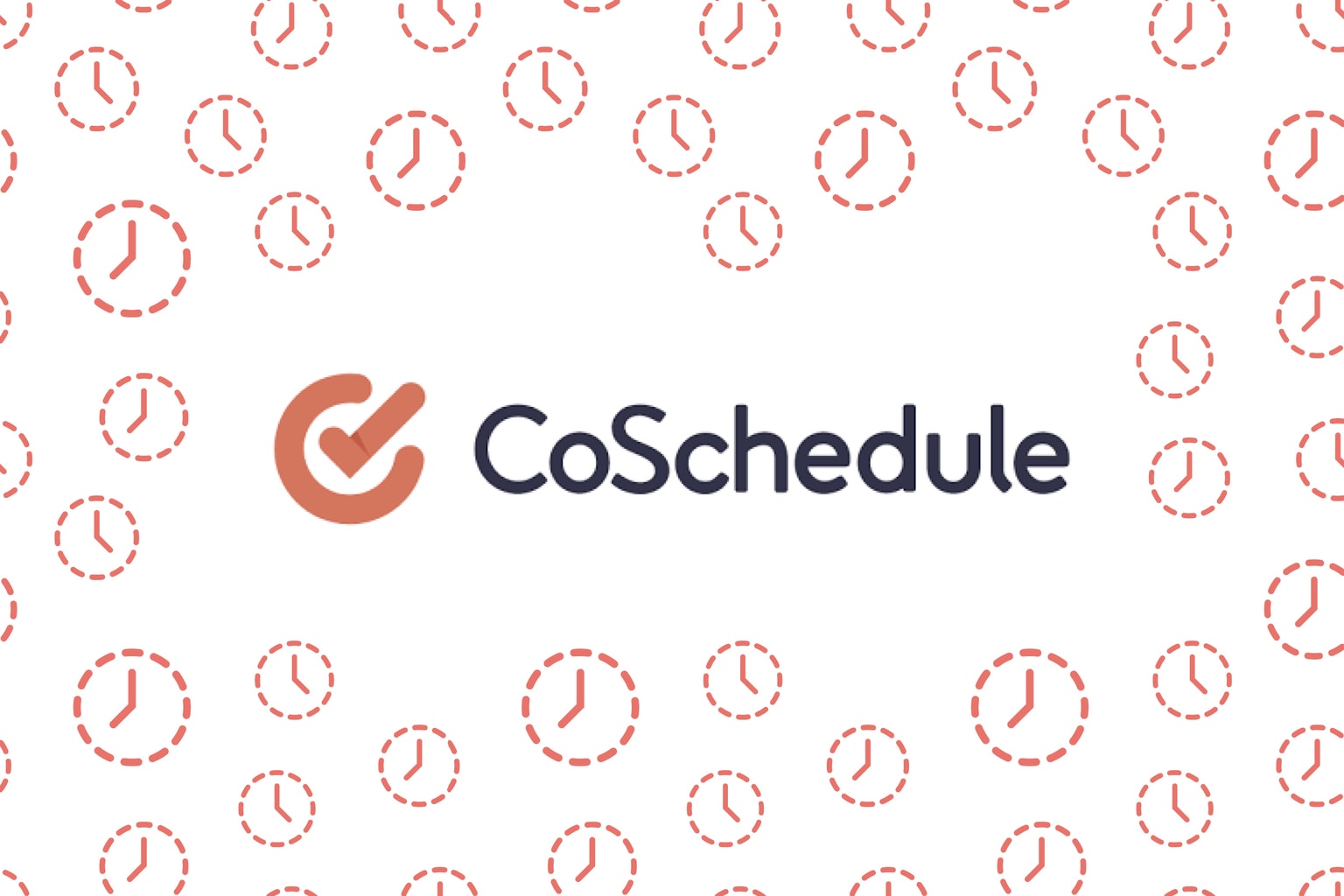
CoSchedule is purpose-built for marketing teams and content calendars.
Pros:
- All-in-one marketing calendar
- Social media scheduling built-in
- Great analytics and reporting features
Cons:
- More expensive than some other options
- Can be overwhelming with all its features
Cool Feature: CoSchedule’s ReQueue feature automatically reshares your best-performing content. It’s like having a content DJ that always knows what to play next!
Airtable

Airtable is like the cool cousin of spreadsheets - it’s got all the power, but with a much sleeker interface.
Pros:
- Extremely flexible and customizable
- Combines the best of spreadsheets and databases
- Has a robust free plan
Cons:
- Can be complex to set up initially
- Might be overkill for simple needs
Pro Tip: Use Airtable’s “Views” feature to create different ways of looking at your content calendar - by month, by platform, by team member, etc. It’s like having multiple calendars in one!
Choosing the Right Tool
Picking the perfect tool depends on your specific needs. Here are some questions to ask yourself:
- How big is your team?
- What’s your budget?
- Do you need advanced features like analytics or social media scheduling?
- How tech-savvy is your team?
Remember, the best tool is the one you’ll actually use. Don’t get caught up in fancy features if a simple spreadsheet will do the trick.
My Personal Favorite: I’ve tried them all, but I always come back to Airtable. Its flexibility lets me track everything from content ideas to performance metrics, all in one place. Plus, the colorful interface makes my inner designer happy!
So there you have it - a smorgasbord of content calendar tools to choose from. Pick your weapon wisely, and you’ll be slaying your content game in no time!
Step 5: Plan Your Content Topics
Okay, now we’re getting to the good stuff! Planning your content topics is like mapping out a road trip - you want to hit all the cool spots and avoid the boring stretches. Let’s dive in and make your content calendar pop with awesome ideas.
Brainstorming Bonanza
First things first, let’s get those creative juices flowing. Grab your team (or just yourself if you’re flying solo) and have a good old-fashioned brainstorming session. Here are some tricks to make it fun:
- Use sticky notes to jot down ideas - it’s like playing Tetris with your thoughts
- Try the “yes, and” technique from improv comedy - build on each other’s ideas without judgment
- Set a timer for 10 minutes and see who can come up with the most ideas - winner gets a coffee!
Leverage Current Events and Trends
Stay on top of what’s happening in your industry. It’s like surfing - you want to catch the wave at just the right moment. Some ways to do this:
- Google Trends It’s like having a crystal ball for popular topics
- Twitter Check out trending hashtags in your niche
- Industry publications: Subscribe to newsletters and RSS feeds
Keyword Research: Your Secret Weapon
Keywords are like the DNA of your content - they tell search engines what you’re all about. Use tools like:
- SEMrush Great for finding keywords your competitors are ranking for
- Ahrefs Awesome for discovering long-tail keywords
- Google Keyword Planner Free and straight from the source
Content Types to Consider
Mix it up! Variety is the spice of life, and it’s also the secret sauce for a killer content calendar. Here are some ideas:
- How-to guides: Like “How to Make the Perfect Sourdough Bread”
- Listicles: “10 Must-Visit Hidden Gems in New York City”
- Case studies: “How Company X Doubled Their Revenue with Our Product”
- Infographics: Visual content that pops on social media
- Video content: Short-form for TikTok or longer for YouTube
Seasonal and Evergreen Content
Balance is key here. It’s like your wardrobe - you need both trendy pieces and classics.
- Seasonal content: Plan for holidays, events, or seasons relevant to your industry
- Evergreen content: Create timeless pieces that are always relevant
User-Generated Content (UGC)
Don’t forget to tap into your audience’s creativity! UGC is like getting a present - it’s exciting and you never know what you’re going to get. Encourage customers to share:
- Reviews
- Photos using your product
- Stories about their experiences
Content Series or Themes
Create a content series or theme. It’s like a TV show - people will tune in regularly if they know what to expect. For example:
- “Tech Tuesdays” for a software company
- “Foodie Fridays” for a restaurant
- “Wellness Wednesdays” for a health brand
Repurpose and Recycle
Don’t reinvent the wheel for every piece of content. Take a cue from nature and recycle:
- Turn a blog post into an infographic
- Create a video series based on your most popular articles
- Break down a long-form piece into bite-sized social media posts
Ask Your Audience
Sometimes the best ideas come straight from the source. Use tools like:
Ask your audience what they want to see. It’s like being a mind reader, but easier!
Plan for Different Platforms
Remember, not all content works everywhere. Tailor your ideas to each platform:
- LinkedIn
 Professional, industry-specific content
Professional, industry-specific content - Instagram Visual, lifestyle-focused posts
- Twitter Quick updates, news, and engagement
Content Idea Table
Here’s a quick reference table to help you plan:
| Content Type | Example | Best Platform | Frequency |
|---|---|---|---|
| Blog Post | “5 Ways to Boost Your Productivity” | Website, LinkedIn | Weekly |
| Short Video | “Quick Tip Tuesday” | TikTok, Instagram Reels | 2-3x per week |
| Infographic | “The State of Remote Work in 2023” | Pinterest, LinkedIn | Monthly |
| User Story | “Customer Spotlight: Sarah’s Success” | All Platforms | Bi-weekly |
| Live Q&A | “Ask Me Anything with Our CEO” | Facebook, Instagram | Monthly |
Remember, planning your content topics isn’t a one-and-done deal. Keep revisiting and refining your ideas. It’s like tending a garden - with regular care, your content will bloom and grow!
Step 6: Create Your Calendar
Alright, it’s showtime! We’ve laid the groundwork, and now it’s time to bring your content calendar to life. Think of this step as assembling your dream team of content - each piece playing its part in your grand strategy.
Choose Your Calendar Format
First things first, you need to decide on the format that works best for you and your team. Here are some popular options:
-
- Great for visual planners and easy team sharing
- Color-code different content types or platforms
-
- Offers flexibility and customization
- Use tabs for different months or platforms
-
- Ideal for larger teams or complex content strategies
- Many offer calendar views and task assignments
Set Up Your Calendar Structure
Now, let’s give your calendar some bones. Here’s a simple structure to get you started:
- Date
- Platform (e.g., blog, Facebook, Instagram)
- Content Type (e.g., blog post, video, infographic)
- Topic/Title
- Status (e.g., idea, in progress, published)
- Assigned Team Member
- Notes/Links
Plan Your Posting Frequency
How often should you post? It depends on your platform and audience. Here’s a general guideline:
- Facebook 1-2 times per day
- Instagram 1-3 times per day
- Twitter 3-5 times per day
- LinkedIn
 1-2 times per week
1-2 times per week - Blog: 1-4 times per month
Remember, consistency is key. It’s better to post less frequently but consistently than to start strong and fizzle out.
Balance Your Content Mix
Think of your content calendar like a well-balanced meal. You want a mix of:
- Promotional content (20%)
- Educational content (40%)
- Entertaining content (30%)
- Curated content (10%)
This keeps your audience engaged without feeling like they’re being sold to all the time.
Schedule Around Important Dates
Don’t forget to mark important dates in your calendar:
- Industry events
- Holidays
- Product launches
- Company milestones
These are great opportunities for themed content.
Use Time-Blocking
Time-blocking can be a game-changer for content creation. Here’s a sample weekly schedule:
- Monday: Content brainstorming and planning
- Tuesday-Wednesday: Content creation
- Thursday: Editing and approval
- Friday: Scheduling and analytics review
Create a Content Bank
Build a backlog of evergreen content. This is your safety net for those weeks when inspiration runs dry or unexpected events throw off your schedule.
Include Call-to-Actions (CTAs)
Every piece of content should have a purpose. Include a column in your calendar for the CTA associated with each post. This keeps your content goal-oriented.
Plan for Social Listening
Set aside time in your calendar for social listening. This helps you stay on top of trends and engage with your audience in real-time.
Use a Content Calendar Template
To get you started, here’s a simple content calendar template:
| Date | Platform | Content Type | Topic/Title | Status | Assigned To | CTA | Notes |
|---|---|---|---|---|---|---|---|
| 6/1 | Blog | How-To Guide | “5 Tips for Better Sleep” | In Progress | Sarah | Download Sleep Tracker | Research sleep stats |
| 6/3 | Image + Caption | “Monday Motivation Quote” | Scheduled | Tom | Like and Share | Use brand colors | |
| 6/5 | Poll | “What’s your biggest productivity challenge?” | Idea | Alex | Engage followers | Tie to upcoming webinar |
Tools to Consider
Some tools that can make calendar creation easier:
- Trello Great for visual organization
- Asana
 Excellent for team collaboration
Excellent for team collaboration - CoSchedule
 Specifically designed for content calendars
Specifically designed for content calendars - Airtable
 Flexible and customizable
Flexible and customizable
Final Tips
- Keep it flexible. Life happens, and you may need to adjust on the fly.
- Review and update regularly. A stale calendar is about as useful as week-old sushi.
- Make it visually appealing. Use colors, icons, or emojis to make your calendar pop.
Creating your content calendar might seem like a big task, but trust me, it’s worth it. It’s like meal prepping for your content strategy - a little effort upfront saves you time and stress in the long run. Now go forth and calendar like a boss!
Step 7: Review and Adjust
You’ve put in the hard work to create an awesome content calendar, but guess what? The job’s not over yet! Think of your content calendar like a living, breathing creature - it needs regular check-ups and sometimes a little makeover to stay healthy and effective.
Regular Check-ins
Set up a schedule for reviewing your content calendar. I like to do a quick daily check, a more in-depth weekly review, and a comprehensive monthly analysis. It’s like giving your calendar a health check-up at different levels.
Daily Check
- Quick glance at scheduled content
- Respond to any urgent comments or messages
- Make sure all posts went out as planned
Weekly Review
- Look at engagement metrics for the past week
- Adjust upcoming content based on what’s working
- Brainstorm new ideas to fill any gaps
Monthly Analysis
- Deep dive into your analytics
- Compare performance against your goals
- Plan major content themes for the upcoming month
Use Analytics to Guide You
Don’t just post and pray! Use tools like Google Analytics or Hootsuite Insights to track how your content is performing. Here are some key metrics to watch:
- Engagement Rate: How many people are interacting with your posts?
- Reach: How many unique users are seeing your content?
- Click-through Rate (CTR) Are people clicking on your links?
- Conversion Rate: Are your calls-to-action (CTAs) working?
Adjust Based on Performance
If something’s not working, don’t be afraid to shake things up! Maybe your audience loves video content but isn’t engaging with your blog posts. Or perhaps your Twitter followers are most active in the evenings, not mornings like you thought. Use these insights to tweak your calendar.
Stay Flexible
Life happens, trends change, and sometimes you need to pivot. Maybe a competitor just launched a similar product, or there’s a sudden viral trend in your industry. Be ready to adjust your calendar on the fly. It’s like being a surfer - you’ve got to be ready to catch the wave when it comes!
Gather Feedback
Don’t forget to ask your audience what they think! Use tools like Instagram polls or SurveyMonkey to get direct feedback. You might be surprised by what you learn.
Keep an Eye on Trends
Stay up-to-date with industry trends and adjust your calendar accordingly. Tools like BuzzSumo or Google Trends can help you spot rising topics in your niche.
Seasonal Adjustments
Remember to adjust your content for different seasons or major events. For example, if you’re in e-commerce, you’ll want to ramp up your holiday content well before December hits.
Content Audit Table
Here’s a simple table to help you audit your content:
| Content Type | Avg. Engagement Rate | Avg. Reach | Avg. CTR | Keep/Adjust/Remove |
|---|---|---|---|---|
| Blog Posts | 5% | 1000 | 2% | Keep |
| Instagram Stories | 15% | 500 | 3% | Adjust (increase frequency) |
| Twitter Polls | 2% | 200 | 1% | Remove |
Learn from Your Wins (and Losses)
When a piece of content performs exceptionally well (or poorly), dig deeper. Was it the topic? The format? The timing? Use these insights to inform future content decisions.
Experiment and Innovate
Don’t be afraid to try new things! Set aside some time in your calendar for experimental content. Maybe it’s a new platform like TikTok, or a different content format like podcasts. You never know what might resonate with your audience.
Keep Your Team in the Loop
If you’re working with a team, make sure everyone’s on the same page about changes to the calendar. Regular team meetings or a shared document can help keep everyone aligned.
Tools for Review and Adjustment
Consider using tools designed for content performance tracking:
- Sprout Social
 Great for social media analytics
Great for social media analytics - SEMrush Useful for tracking SEO performance
- Trello Can be used to visualize your content pipeline and easily move things around
Remember, the key to a successful content calendar is adaptability. It’s not set in stone - it’s more like a roadmap that can be redrawn as you discover new and exciting destinations. So keep reviewing, keep adjusting, and watch your content strategy soar!
Step 2: Know Your Audience
Knowing your audience is like having a secret superpower in the content world. It’s the difference between shouting into the void and having a cozy chat with your best friend. Let’s dive into how you can really get to know the people you’re creating content for.
Create Buyer Personas
First things first, let’s create some buyer personas. These are like imaginary friends, but way more useful. Here’s how to do it:
- Gather data: Use tools like Google Analytics to learn about your website visitors.
- Survey your audience: Ask them directly what they want. It’s like mind-reading, but legal!
- Talk to your sales team: They’re on the front lines, chatting with customers every day.
- Check out social media: See what your followers are talking about. It’s like eavesdropping, but encouraged.
Example Buyer Persona: Meet Sarah the Social Media Manager
- Age: 28
- Location:Chicago
- Job: Social Media Manager at a startup
- Challenges: Staying on top of trends, proving ROI to bosses
- Goals: Grow the company’s social media following, increase engagement
- Favorite platforms:Instagram and TikTok
Use Data to Inform Decisions
Data is your new BFF. It tells you what your audience likes, when they’re online, and what makes them click. Here are some key metrics to watch:
- Engagement rate: Are people actually interacting with your content?
- Click-through rate: Are they curious enough to learn more?
- Time on page: Are they sticking around or bouncing faster than a rubber ball?
Tools for Audience Research
- Facebook Audience Insights
 It’s like X-ray vision for your Facebook audience.
It’s like X-ray vision for your Facebook audience. - Twitter Analytics
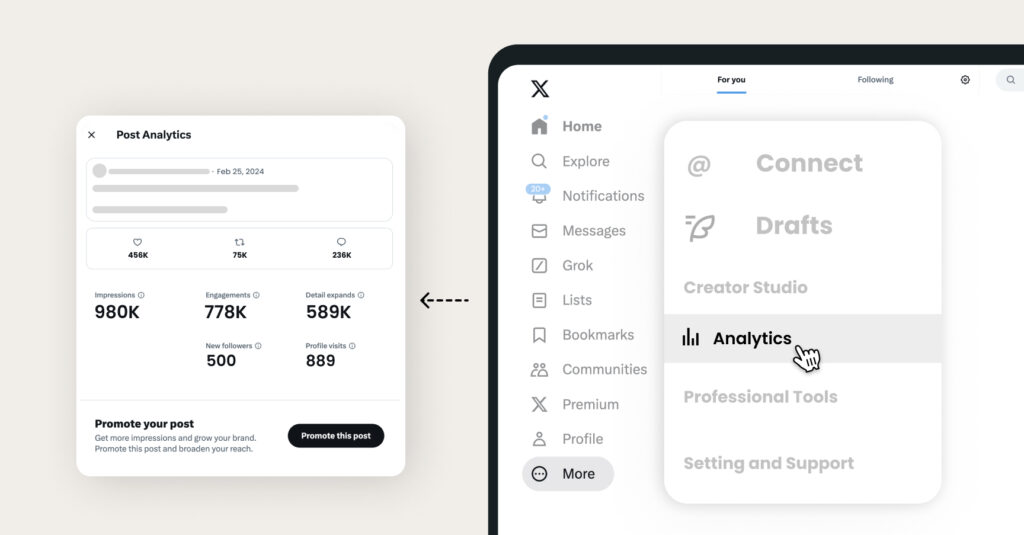 Find out what makes your followers tweet.
Find out what makes your followers tweet. - LinkedIn Analytics
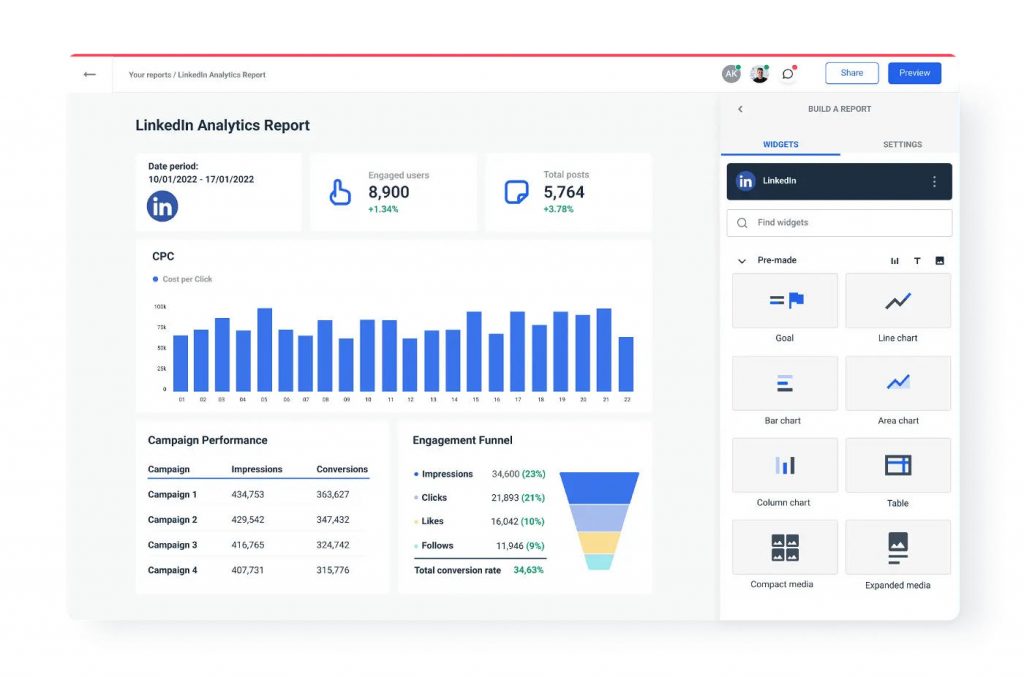 Perfect for B2B businesses trying to crack the professional code.
Perfect for B2B businesses trying to crack the professional code.
Listen to Your Audience
Set up some social listening tools. It’s like having super-hearing for the internet. Try tools like Hootsuite or Sprout Social. They’ll help you:
- Track mentions of your brand
- Find out what people are saying about your industry
- Spot trends before they’re trending
Engage and Ask Questions
Don’t be shy! Talk to your audience. Use polls, ask questions in your posts, or even slide into their DMs (respectfully, of course). Here are some ideas:
- Run an Instagram poll asking what content they want to see next
- Host a Twitter Q&A session
- Create a Facebook group for your most engaged fans
Analyze Your Competition
Check out what your competitors are up to. It’s not cheating, it’s research! Look at:
- What kind of content they’re posting
- How often they post
- Which posts get the most engagement
Create Content for Different Stages of the Buyer’s Journey
Remember, not everyone in your audience is at the same stage. Create content for:
- Awareness: They’re just getting to know you. Think blog posts and infographics.
- Consideration: They’re thinking about buying. Case studies and comparison guides work well here.
- Decision: They’re ready to pull the trigger. Testimonials and free trials are your best friends.
Keep Your Finger on the Pulse
Trends change faster than a chameleon on a disco floor. Stay updated by:
- Following industry thought leaders on social media
- Subscribing to relevant newsletters
- Attending webinars and conferences (even virtual ones count!)
Test and Learn
Finally, don’t be afraid to experiment. Try new things and see how your audience reacts. It’s like being a mad scientist, but with content. Use A/B testing to:
- Try different headlines
- Test various content formats
- Experiment with posting times
Remember, knowing your audience isn’t a one-and-done deal. It’s an ongoing process. Keep listening, keep learning, and keep adapting. Your content will thank you for it!
Step 3: Choose Your Content Types
Picking the right content types is like choosing ingredients for a killer recipe - you want a mix that’ll make your audience come back for seconds! Let’s break down some popular content types and how to use them effectively in your social media strategy.
Blog Posts

Blog posts are the bread and butter of content marketing. They’re great for:
- Establishing thought leadership
- Improving SEO
- Providing in-depth information on topics
Pro Tip: Aim for a mix of evergreen content (always relevant) and timely pieces (trending topics).
Infographics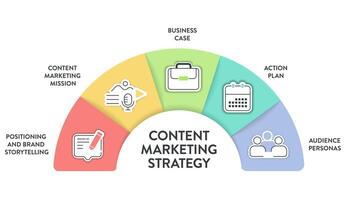
People love visual content, and infographics are a great way to present complex information in an easily digestible format.
Cool Tool: Try Canva for creating stunning infographics, even if you’re not a design pro.
Video Content
Video is king in the social media world. Consider these formats:
- Short-form videos: Perfect for TikTok and Instagram Reels
- Live streams: Great for Facebook and Instagram to interact with your audience in real-time
- Tutorials: Show your expertise on YouTube
Fun Fact: According to Wyzowl, 86% of businesses use video as a marketing tool in 2023.
Podcasts
Podcasts are booming, and they’re a great way to connect with your audience on a deeper level.
- Perfect for multitaskers who can listen while doing other activities
- Can be repurposed into blog posts or social media snippets
Insider Tip: Use a tool like Anchor to easily record and distribute your podcast.
User-Generated Content (UGC)
UGC is like striking gold - it’s authentic, engaging, and doesn’t require you to create it from scratch!
- Encourages audience participation
- Builds trust and authenticity
Example: GoPro often features user-submitted photos and videos on their Instagram, showcasing the versatility of their products.
Quizzes and Polls
Interactive content can boost engagement and provide valuable insights about your audience.
- Great for Facebook and Instagram Stories
- Can be used to gather data or just for fun
Try This: Create a quiz that helps users determine which of your products is right for them.
Case Studies
Case studies showcase real-world applications of your products or services.
- Perfect for B2B companies
- Can be shared on LinkedIn or your website
Pro Move: Turn your case study into an eye-catching infographic for easy sharing on social media.
Content Type Comparison Table
| Content Type | Best Platforms | Time Investment | Engagement Potential | SEO Value |
|---|---|---|---|---|
| Blog Posts | Website, LinkedIn | High | Medium | High |
| Infographics | Pinterest, LinkedIn | Medium | High | Medium |
| Short Videos | TikTok, Instagram | Low | Very High | Low |
| Podcasts | Spotify, Apple Podcasts | High | Medium | Medium |
| UGC | Instagram, Facebook | Low | High | Medium |
| Quizzes/Polls | Facebook, Instagram | Low | High | Low |
| Case Studies | LinkedIn, Website | High | Medium | High |
Mix and Match
The key is to mix different content types to keep your audience engaged. Here’s a sample weekly content mix:
- Monday: Blog post
- Tuesday: Infographic (based on blog post)
- Wednesday: Short video tip
- Thursday: User-generated content feature
- Friday: Instagram poll
- Saturday: Podcast episode
- Sunday: Motivational quote graphic
Remember, it’s not about being everywhere, but about being where your audience is and providing value. Experiment with different content types, track what works best, and adjust your strategy accordingly. Happy content creating!
Bonus: Content Calendar Templates
Ready to kickstart your content planning? I’ve got you covered with some killer templates that’ll make your content calendar shine brighter than a supernova. Let’s dive in!
Google Sheets
 Content Calendar Template
Content Calendar Template
Google Sheets is like the Swiss Army knife of content calendars - versatile, accessible, and oh-so-shareable. Here’s a template to get you started:
- Content Calendar for Social Media

- Features: Color-coded content types, separate tabs for each platform
- Best for: Small teams, startups, solo content creators
- Pro tip: Use the ‘Data Validation’ feature to create dropdown menus for status updates
Trello Board Template
Board Template
Trello’s visual layout is perfect for those who think in sticky notes and whiteboards. Check out this template:
- Editorial Calendar

- Features: Kanban-style workflow, easy drag-and-drop functionality
- Best for: Visual thinkers, agile teams
- Cool hack: Use the ‘Calendar Power-Up’ to view your board as a traditional calendar
Airtable
 Content Calendar
Content Calendar
Airtable is like the cool cousin of spreadsheets - it’s got all the power, but with a much sleeker interface. Here’s a template to try:
- Social Media Calendar
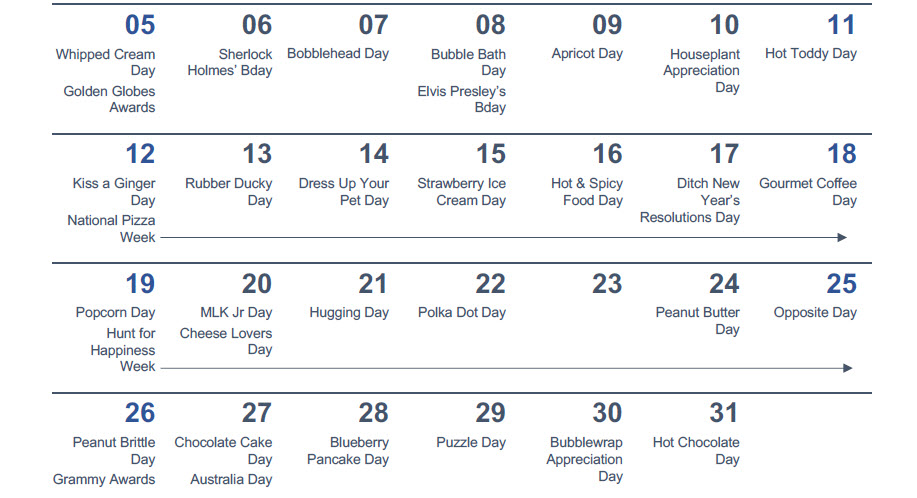
- Features: Multiple views (calendar, kanban, gallery), customizable fields
- Best for: Data-driven marketers, larger teams
- Insider tip: Use the ‘Automations’ feature to set up reminders and notifications
Asana
 Marketing Calendar Template
Marketing Calendar Template
Asana’s robust features make it a powerhouse for content planning. Check out this template:
- Marketing Calendar

- Features: Timeline view, task dependencies, team assignments
- Best for: Mid-size to large marketing teams
- Power move: Use the ‘Forms’ feature to collect content ideas from your team
DIY Excel Template
Sometimes, you just can’t beat a good old-fashioned Excel spreadsheet. Here’s a simple template you can recreate:
| Date | Platform | Content Type | Topic/Title | Status | Assigned To | Notes |
|---|---|---|---|---|---|---|
| 6/1 | Blog | How-To Guide | “5 Ways to Boost Your SEO” | In Progress | Sarah | Include case study |
| 6/3 | Image + Caption | “Monday Motivation” | Scheduled | Tom | Use brand colors | |
| 6/5 | Poll | “What’s your biggest marketing challenge?” | Idea | Alex | Tie to upcoming webinar |
Template Comparison Table
| Template | Best For | Ease of Use | Collaboration | Visual Appeal | Price |
|---|---|---|---|---|---|
| Google Sheets | Small teams, startups | ⭐⭐⭐⭐ | ⭐⭐⭐⭐⭐ | ⭐⭐⭐ | Free |
| Trello | Visual thinkers | ⭐⭐⭐⭐⭐ | ⭐⭐⭐⭐ | ⭐⭐⭐⭐⭐ | Free/Paid |
| Airtable | Data-driven marketers | ⭐⭐⭐ | ⭐⭐⭐⭐ | ⭐⭐⭐⭐ | Free/Paid |
| Asana | Larger teams | ⭐⭐⭐ | ⭐⭐⭐⭐⭐ | ⭐⭐⭐⭐ | Free/Paid |
| Excel | DIY enthusiasts | ⭐⭐⭐⭐ | ⭐⭐ | ⭐⭐ | Paid |
Customizing Your Template
Remember, these templates are just starting points. Don’t be afraid to tweak them to fit your specific needs. Here are some ideas:
- Add a column for hashtags if you’re focusing on social media
- Include a field for target keywords if SEO is a priority
- Create a section for content repurposing ideas
Template Best Practices
- Color code: Use different colors for different content types or platforms. It’s like giving your calendar a mini-makeover!
- Use consistent naming conventions: It’ll make searching and sorting a breeze
- Include a ‘Notes’ column: For those brilliant ideas that pop up at 2 AM
- Add a ‘Performance’ section: Track those metrics, baby!
My Personal Favorite
After trying out more tools than I can count, I always come back to Airtable. It’s flexible enough to adapt to my ever-changing content needs, but powerful enough to handle complex workflows. Plus, the ability to switch between calendar, kanban, and gallery views? Chef’s kiss
Remember, the best template is the one you’ll actually use. So pick one that vibes with your style, customize it to your heart’s content, and watch your content game soar to new heights. Happy planning!
FAQs About Content Calendars
Got questions about content calendars? You’re not alone! Let’s dive into some of the most common head-scratchers and demystify this essential tool for content creation.
What is a content calendar?

A content calendar is your roadmap for content creation and distribution. It’s like having a personal assistant who keeps track of what you’re posting, where you’re posting it, and when. This nifty tool helps you plan, organize, and schedule your content across various platforms, keeping you consistent and on-brand.
How often should I update my content calendar?
The golden rule? Update it regularly! I like to do a quick daily check, a more in-depth weekly review, and a comprehensive monthly analysis. Think of it like tending a garden - a little bit of care every day keeps everything blooming.
What should I include in my content calendar?
At a minimum, your calendar should include:
- Publication date
- Content type (blog post, social media update, video, etc.)
- Platform or channel
- Topic or headline
- Status (idea, in progress, published)
- Assigned team member
For bonus points, consider adding:
- Keywords or hashtags
- Call-to-action (CTA)
- Promotional plans
- Performance metrics
How far in advance should I plan my content?
It depends on your business and content type, but I usually recommend planning at least a month ahead. For bigger projects or campaigns, you might want to look 3-6 months out. It’s like meal prepping for your content strategy!
Can a content calendar help with SEO?
Absolutely! A well-planned content calendar can be a secret weapon for Search Engine Optimization (SEO). By planning your content in advance, you can:
- Ensure a good mix of keywords
- Create content clusters around specific topics
- Plan for seasonal trends and events
What tools can I use to create a content calendar?
There are tons of great options out there! Here are a few popular choices:
- Google Sheets Free and easy to use
- Trello Great for visual planners
- Asana Excellent for team collaboration
- CoSchedule Designed specifically for content calendars
- Airtable Flexible and customizable
How do I come up with content ideas for my calendar?
Coming up with fresh ideas can be tough, but here are some tricks:
- Use Google Trends to spot rising topics
- Set up Google Alerts for industry news
- Look at your competitors (but don’t copy!)
- Ask your audience what they want to see
- Repurpose your best-performing content
Should I plan different content for different platforms?
Yes, yes, and yes! Each platform has its own vibe and audience expectations. For example:
- LinkedIn
 Professional, industry-focused content
Professional, industry-focused content - Instagram Visual, lifestyle-oriented posts
- Twitter Quick updates, news, and engagement
How do I measure the success of my content calendar?
It’s all about the metrics, baby! Here are some key performance indicators (KPIs) to watch:
- Engagement rate
- Reach and impressions
- Click-through rate (CTR)
- Conversion rate
- Time on page (for blog posts)
Use tools like Google Analytics or social media insights to track these.
What if I can’t stick to my content calendar?
Don’t sweat it! Life happens, and sometimes you need to pivot. The key is to stay flexible. If you miss a post, don’t try to make it up - just pick up where you left off. It’s like falling off the diet wagon - one slip-up doesn’t ruin everything!
Can I use a content calendar for multiple brands or clients?
Absolutely! Many content creators and agencies manage multiple calendars. Just make sure to keep them separate and clearly labeled. It’s like juggling - tricky at first, but you’ll get the hang of it!
How do I balance planned content with real-time engagement?
Great question! While planning is crucial, you also need room for spontaneity. I like to follow the 80/20 rule:
- 80% planned content
- 20% flexible for real-time engagement and trending topics
This way, you stay consistent while still being able to jump on those viral trends or respond to current events.
Remember, a content calendar is a tool to help you, not a rigid set of rules. Use it to stay organized and consistent, but don’t be afraid to shake things up when inspiration strikes. Happy planning!

